The Poetic Edda (also known as The Elder Edda) is a collection of Old Norse poems. It is the primary source for what we know about Norse mythology today. In contrast to the so-called Younger Edda, or Prose Edda, written by Snorri Sturluson, the authors of the Poetic Edda are unknown.
Origins of the poems in the Poetic Edda
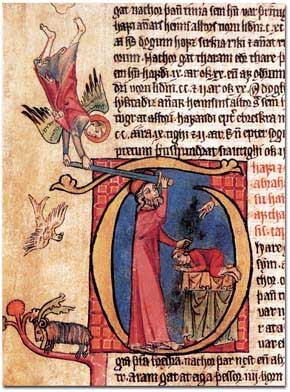
Maybe the most important thing to understand about the Poetic Edda is that it was never one book. The different poems making up the collection we often perceive as a whole were originally separate poems. They were written by different poets, possibly hundreds of years apart as well as from different parts of Scandinavia and Iceland.
Some of the older poems are believed to have been written in the 9th or 10th century, or possibly even earlier. The latest poems were likely written in the 11th or 12th centuries. This was shortly before the separate poems came to be a collection.
However, when we are trying to understand the age of any given poem, it is basically based on the words and grammar used. That disregards the fact that these poems probably lived long before they were ever written down, or performed by poets.
In the Viking Age, stories often came in the form of an entertainer performing them as a song or poem. They would develop over time, and change slightly both over time and across distances and countries. That is not to say that the main themes weren’t fairly stable, but there wasn’t one true original version.
Other drivers of change would have been the variations of beliefs from one region to another, or through time. Gods’ roles and importance changed somewhat for some of them, and that could also lead to slight variations.
The different versions of the Poetic Edda
There is another thing that might cause some confusion when we speak about the Poetic Edda. There isn’t just one collection of poems, rather there are several similar, yet different collections of mostly the same poems.
The most complete and well-preserved edition is the 45-page vellum manuscript known as Codex Regius (Iceland Konungsbók). It is made up of 31 poems but is missing eight pages, so a few poems are lost as well. It is believed to have been written around 1270 in Iceland and likely changed hands many times. Then in 1643, almost four hundred years later, it came to be owned by Bishop Brynjólfur Sveinsson.
Some twenty years later, in 1662 Brynjólfur Sveinsson decided to give it as a gift to Frederick III, king of Denmark and Norway. Then it became known as the Codex Regius, and was kept at the Royal Library in Copenhagen. It was kept there for more than three hundred years until it was returned to Iceland in 1971.
You can leaf through the original manuscript here, cataloged as GKS 2365 4to, part of the Árni Magnússon Institute collection.
Other manuscripts with Poetic Edda poems
As mentioned above, Codex Regius is not the only version of a collection of the poems of the Poetic Edda. There are a few more manuscripts that are written later. They all have one or a few poems that today are seen as part of the Poetic Edda collection. However, none are complete as the Codex Regius.
Among these the most notable are known as AM 748 I 4to, Flateyjarbók and the Edda Oblongata. These manuscripts are housed in Icelandic libraries and archives, such as the Árni Magnússon Institute for Icelandic Studies in Reykjavik or the Arnamagnæan Institute in Copenhagen.
The AM 748 I 4to is an interesting manuscript for what it adds to the Codex Regius. While it is short with only six poems, it is the only one which includes Baldrs Draumar. Being an important part of the Old Norse myths, Baldrs Draumar tells of how Baldur is having troublesome dreams. The story and consequences following the sad death of Baldur sets in motion a series of events leading to Ragnarok.
Flateyjarbók (Book of Flatey –flat island) is the largest of the medieval Icelandic manuscripts with a whopping 225 pages. Written in 1387 to 1394, it is by and large old sagas about Norse kings, with one interesting exemption. In addition to the sagas, the Flateyjarbok has the only known version of the Hyndluljóð, The Lay of Hyndla. A distinctly mythological Eddic poem in its style, it tells of how Freyja meets a völva named Hyndla.
The Edda Oblongata (Langa Edda) is most noteworthy because of its odd shape, being long and narrow. Believed to have been written in 1680 it contains a number of colorful illustrations of the gods and mythological motifs. I recommend having a look for the illustrations alone!
The Poetic Edda and the Prose Edda (Elder and Younger)
The two best-known works about Norse mythology, the Eddas, are actually two very different types of books, or collections. The Poetic Edda poems largely have unknown origins, the Prose Edda however was likely, or mostly written by Snorri Sturluson.
While this last point isn’t entirely certain, the Prose Edda (Younger Edda) is commonly known as written by Snorri. Before the re-discovery of the Poetic Edda in the 17th century, the Prose Edda was commonly known as just the Edda. However, at the time it was believed that there had to have existed an older collection of poems that Snorri had used as source material.
Upon the discovery of the Poetic Edda, the two “Eddas” came to be known as the Younger, and Elder Edda. The poems of the latter are seen as having been the source of much of Snorri’s prose writing in his own books.
Most likely though, there were other versions of the poems of the Poetic Edda written long before the Codex Regius that Snorri might have had access to. Sadly, both time and the Christian reformation claimed many old books and manuscripts to deteriorate and to book burnings.
The Poems of the Poetic Edda
The poems of the Poetic Edda are divided between mainly mythological ones and heroic poems about Norse heroes. While most of the poems are found in the Codex Regius, a few are only found in other manuscripts.
The Mythological Poems and Lays
(Included in the Codex Regius)
Völuspá – The Prophecy of the Seeress
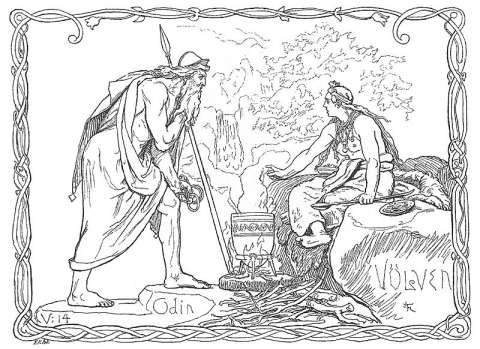
Thought to be one of the oldest surviving works of Norse literature and is believed to first have been written in the 10th century. The Völuspá is presented as a prophecy given by a seeress, and tells the story of the creation of the world, the deeds of the gods, and the eventual destruction of the world in Ragnarok, the Norse apocalypse.
It also includes references to many of the prominent Norse gods, such as Odin, Thor, and Freyja, and their role in the events described in the poem. The poem also describes how the world will be recreated after Ragnarok, and how a few of the gods will arise to rule the world.
Hávamál – Sayings of the High One
In this poem, Odin shares his wisdom and advice, including moral codes, and how to live a good life. The Hávamál covers a wide range of topics including, wisdom, wit, and the importance of being a good host and guest. Covering many topics, quite a few of his words of wisdom would not be advisable to take literally today.
The poem is also thought to contain elements of magic and spell casting, and is believed to have been used as a source of guidance and instruction for Viking warriors.
Vafþrúðnismál – The Lay of Vafthrúdnir
The Vafthruthnirsmál tells the story of Odin’s visit to the giant Vafthrudnir, where the two engage in a contest of wisdom and knowledge. Vafthrudnir poses a series of questions to Odin, who must answer them correctly in order to win the contest. A wager on their heads no less. The poem covers a wide range of topics, including Norse mythology, cosmology, and the history of the world.
It also contains many kennings, a type of metaphorical phrase used in Norse poetry, which add to the poetic complexity of the poem. The poem is considered to be one of the most important sources of Norse mythology and is rich in Norse cosmological and cosmogonic concepts.
Grímnismál – The Lay of Grímnir
In Grimnismal, Odin is a prisoner and chained between two fires. Only receiving help from a young boy named Agnar Odin tells many things about the gods and Asgard.
Much like the Vafthrudnirsmal, the poem contains a lot of mythological information that Snorri leaned on for his book Gylfaginning.
Skírnismál – The Lay of Skírnir
Somewhat like a Norse version of Romeo and Juliet, Skirnismal tells the story of how Freyr and Gerd connect. Freyr is sitting in Hlidskjalf one day when he sees Gerd deep in Jotunheim. Instantly smitten by her beautiful looks, his servant Skirnir travels to convince her to marry Freyr.
With little in the way of mythological facts, the poem is more pure entertainment and quite graphic in its descriptions. Poor Gerd is promised quite a bleak future to put it mildly unless she agrees to the proposal.
Hárbarðsljóð – The Lay of Hárbard
The poem Harbardsljod recounts a time Thor meets Odin in diguise and an argument ensues. Thor is on his way home from one of his adventures in Jotunheim when he comes to a wide and deep sound. On the other side stands a ferryman that Thor shouts to come and get him. Odin, in the guise of the ferryman, Harbard refuses Thor and a shouting match of threats and insults ensues.
Hymiskviða – Hymir’s Poem
The Hymiskvida gives great insight into the often fraught relationship between the Aesir gods and the jotnar. This story tells of the time Thor and Tyr venture into Jotunheim hoping to get a large cauldron from Tyr’s jötun father Hymir.
Thor comes eye-to-eye with his nemesis Jormungand, and the Aesir god Tyr has to face his jötun parents. What the story lacks of mythological information it makes up for in pure entertainment value.
Lokasenna – The Flyting of Loki
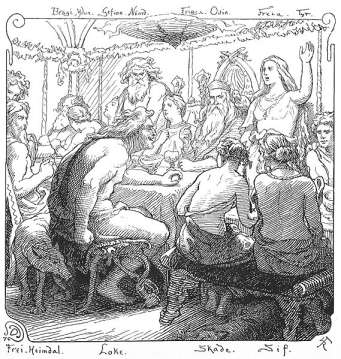
Lokasenna tells the story of a flyting, or poetic insult contest, between the god Loki and the other gods and goddesses at a feast in Aegir’s hall. Loki crashes the feast and starts insulting and taunting the gods and goddesses. However this is mostly one-sided as no one of the gods take the bait.
The poem is notable for its use of humor and satire, and its portrayal of the gods as flawed and human-like figures. It provides a lot of information about the Norse gods, their personalities, and their interactions with each other. Interestingly, many of the facts or stories Loki references are unknown to us today, so likely part of the stories were lost in time.
Þrymskviða – Thrym’s Poem
In the Thrymskvida the giant Thrym steals Thor’s hammer and demands Freyja, the goddess of love and fertility, as his bride in exchange for its return. The gods however come up with a plan to retrieve Thor’s hammer, with Thor disguising himself as Freyja and Loki as her maid.
The poem is notable for its use of humor and satire, and its depiction of the very manly Thor in a comic light. It is also one of many examples of how Loki, the one ultimately bringing the world to an end, is instrumental in helping Thor and the other gods.
Völundarkviða – The Lay of Völund
Tells the story of Völund, a legendary smith and king of the elves who is captured by a human king and forced to make treasures for him. Völund ultimately takes revenge on the king by killing his sons and raping his daughter Boldvild, before flying away on wings he had made himself.
The poem is notable for its complex and nuanced portrayal of Völund as both a skilled craftsman and a (very) vengeful hero.
Alvíssmál – The Lay of Alvís
Alvíssmál tells of a contest between the god Thor and the dwarf Alvis. The story begins with the dwarf Alvis coming home to Thor, asking for the hand of his daughter Thrud in marriage. This has apparently been promised to him as some payment for something he has done. Thor however was not part of the arrangement and will not go along with it.
Their talk turns into a protracted talk about what different things are called in the various realms. In the end, Thor exclaims that he has tricked Alvis as the sun is coming up and the poor dwarf turns into stone.
(Not found in the Codex Regius)
Baldrs draumar – Baldr’s Dreams (or Vegtamskvida)
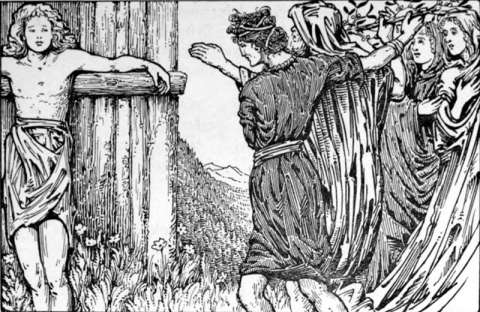
This poem tells the story of the god Baldr’s dreams and his eventual death. It begins with Baldr having nightmares about his own death, which causes him to become worried and seek the advice of the other gods. The gods decide to seek the advice of a völva, who tells them that Baldr’s death will come at the hands of his own brother, Hodr. Despite the gods’ attempts to prevent this, Hodr, misguided by Loki, eventually kills Baldr with a mistletoe spear.
Overall, the poem explores the very Old Norse themes of fate, prophecy, and the power of dreams. In a way, it is mimicking the inevitability that all the gods have in escaping their own doom.
Gróttasöngr – The Song of Grótti
Gróttasöngr is by some considered part of the Poetic Edda. It tells the story of two young slave girls bought by the Danish King Frodi. The girls are brought to a magic mill stone to grind out wealth for the king and sing for his household. Despite being ordered to grind continuously, the girls remain benevolent and sing, wishing wealth and happiness for the king.
The girls as it turns out, have a mysterious past and in the end, things don’t quite go the way king Frodi had wished. The girls create an army with the magical mill stones, the king is killed and in the end, the mill stones end up at the bottom of the sea. There it grinds still, creating all the salt in the oceans.
Rígsþula – The Song of Ríg
Tells the story of a Norse god calling himself Rig (this likely meant to be Odin, but it says Heimdall in the introduction to the poem) and his creation of the social classes of mankind. Ríg is described as “old and wise, mighty and strong.” In the poem, Ríg travels the world and fathers the children who become the first of the three classes of society.
The poem appears in the Codex Wormanius, a manuscript of Snorri’s Prose Edda, but the end of the poem is missing due to the manuscript’s incompleteness. We are left with Rig taking a special interest in one of the children and his son is later called Kon-ungr (Konung, King).
Hyndluljóð – The Poem of Hyndla
Hyndluljóð is a late Eddic poem, believed to have been written in the second half of the 12th century or later. The poem tells the story of the goddess Freyja and the völva Hyndla riding together towards Valhalla. Freyja is on her boar Hildisvíni and Hyndla is on a wolf.
The poem mainly consists of Hyndla reciting names from Óttarr’s ancestry. The wise-woman Hyndla, being asked by Freyja to trace the ancestry of her favorite Ottar for the purpose of a wager, gives a complex genealogy including many of the heroes who appear in popular sagas.
Völuspá in skamma – The short Völuspá
An interpolation in the Hyndluljód poem, the “Short Völuspá” is seen as an inferior version, as well as being shorter, than the traditional Völuspá.
The Heroic Poems and Lays
(Included in the Codex Regius)
The Helgi Hundingabana Lays
Helgi Hundingsbane is a hero in Norse sagas and appears in two poems in the Poetic Edda: “Helgakviða Hundingsbana I” and “Helgakviða Hundingsbana II.” The poems tell the story of Helgi and his wife Sigrún who is a valkyrie.
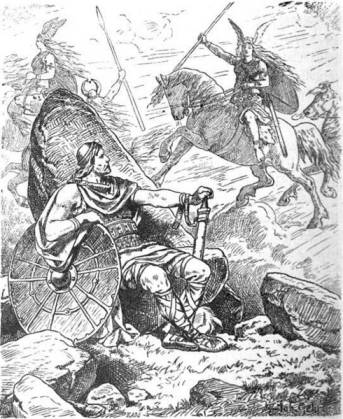
In fact, they were reincarnated as Helgi Hjörvarðsson and Sváva in the poem “Helgakviða Hjörvarðssonar” which is the third of the Helgi Lays. The location and events in the poems have been debated, with both Danish and Swedish scholars claiming them for themselves. While the geography is disputed, the Helgu lays are Scandinavian in origins.
The Niflung Cycle
1. Frá dauða Sinfjötla – (On the death of Sinfjötli)
2. Grípisspá – (Grípir’s prophecy)
3. Reginsmál – (Reginn’s poem)
4. Fáfnismál – (Fáfnir’s poem)
5. Sigrdrífumál – (Sigrdrífa poem)
6. “The Great Lacuna” A section where eight pages are missing in the Codex Regius
Brot af Sigurðarkviðu (Follows the missing section, last 22 stanzas of a poem about Sigurd)
7. Guðrúnarkviða I – (First Lay of Guðrún)
8. Sigurðarkviða hin skamma – (The Short Lay of Sigurd)
9. Helreið Brynhildar – (Brynhild’s Hel-Ride)
10. Dráp Niflunga – (Niflungs’ Killing)
11. Guðrúnarkviða II – (The Second Lay of Gudrún)
12. Guðrúnarkviða III – (The Third Lay of Gudrún)
13. Oddrúnargrátr – (Oddrún’s Lament)
14. Atlakviða – (The Lay of Atli)
15. Atlamál – (The Greenlandic Lay of Atli)
The poems in the so-called Niflung Cycle are in great part the source material for the Saga of the Völsungs. In the saga, we meet both, Fafnir the dragon, Sigurd the Dragonslayer and Brunhild the Valkyrie among others in the saga. Different from the Helgi lays, the poems of the Niflung Cycle are Germanic in origin.
The Jörmunrekkr Lays
1. Guðrúnarhvöt – (Guðrún’s Cause)
2. Hamðismál – (Talk of Hamðir)
The last two lays of the Poetic Edda are about the Gothic king Jörmunrekkr, related to Sigurd and Gudrun of the Niflung Cycle through marriage to their daughter Svanhild. Seemingly thinking his wife had double-crossed him, Jörmunrekkr had his wife trampled to death by horses. Later the lovely Jörmunrekkr pays for his actions.
Thoughts On Reading The Poetic Edda
I hope that this introduction to the Poetic Edda might have made you more curious about reading the different poems. In the poems, you will not only find entertaining literature but an invaluable insight into Old Norse culture and beliefs.
Imagine hearing these stories sitting on a bench inside a great hall, the hushed din of people all around you. A great fire in the middle of the room, creating dancing shadows bringing the gods and heroes to life.
Maybe the second best thing is to take some of the stories along with you on a hike. Light a fire and dive into the stories, or read them aloud for someone else.
Featured Image Credit: Wikimedia Commons
